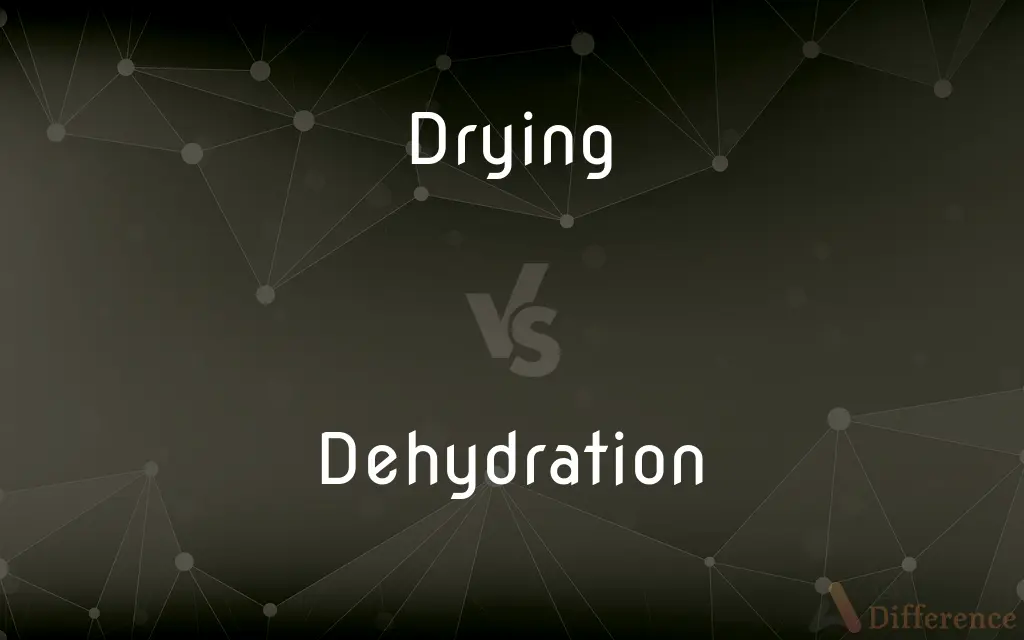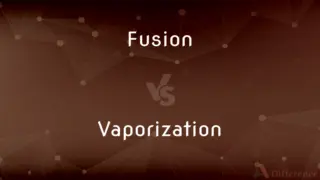Drying vs. Dehydration — What's the Difference?
By Maham Liaqat & Fiza Rafique — Updated on April 17, 2024
Drying involves removing moisture from materials, often using air or heat, while dehydration specifically extracts water to preserve substances.

Difference Between Drying and Dehydration
Table of Contents
ADVERTISEMENT
Key Differences
Drying is a broad term used to describe the process of removing moisture from any material, which can be achieved through natural or artificial means. Whereas dehydration refers specifically to the removal of water from substances, primarily to preserve them. This distinction highlights that while all dehydration is a form of drying, not all drying is dehydration.
In the context of food preservation, drying can be done using air, sun, or an oven, and it doesn't necessarily remove all moisture. On the other hand, dehydration is a controlled method that aims to eliminate as much water as possible without cooking the food, often using devices like food dehydrators.
Drying can affect the texture and weight of materials, making them lighter and more brittle. Whereas dehydration carefully reduces the water content to minimize damage or changes to the physical structure, preserving nutritional content and extending shelf life.
The methods used in drying vary widely, from simple air drying to using sophisticated equipment like freeze dryers. Conversely, dehydration processes are more uniform and often involve either mechanical heating or chemical agents to ensure thorough water removal.
Drying is often less energy-intensive and can be accomplished even in natural settings without special equipment. On the other hand, dehydration typically requires a controlled environment and energy input, making it more resource-intensive but also more efficient in water removal.
ADVERTISEMENT
Comparison Chart
Definition
Process of removing moisture from materials.
Process of specifically removing water to preserve substances.
Typical Use
General applications like clothes drying, industrial processes.
Food preservation, pharmaceuticals, and laboratory settings.
Method Variability
Can vary from natural to high-tech methods.
Usually involves consistent, controlled conditions.
Energy Consumption
Generally lower, can be passive (e.g., air drying).
Often higher due to the use of specialized equipment.
End Result
Reduced moisture content, possible change in texture.
Significantly reduced water content, preserved integrity and extended shelf life.
Compare with Definitions
Drying
Drying something by exposing it to air in a natural or controlled environment.
The laundry was air drying outside.
Dehydration
Devices specifically designed to remove moisture from food.
Using a food dehydrator, she prepared dried mangoes at home.
Drying
Using an oven to accelerate the moisture removal process.
Oven drying the herbs preserves their aroma.
Dehydration
Removing water under reduced pressure.
Vacuum dehydration is used to dry foods while preserving their nutritional content.
Drying
Employing heat to expedite moisture removal.
Thermal drying is often used in the processing of clay.
Dehydration
Using chemical agents to draw water out of materials.
Chemical dehydration is crucial in the preparation of certain dry chemicals.
Drying
Process of losing or removing water or moisture.
After washing, the pottery needs drying in the sun.
Dehydration
Applying heat to remove water content efficiently.
Heat dehydration is often used for making jerky.
Drying
A drying process that freezes the material before reducing the surrounding pressure to remove moisture via sublimation.
Freeze drying coffee helps in retaining its flavor.
Dehydration
Process of removing water from materials, usually to preserve them.
Dehydration of fruits creates tasty, long-lasting snacks.
Drying
Drying is a mass transfer process consisting of the removal of water or another solvent by evaporation from a solid, semi-solid or liquid. This process is often used as a final production step before selling or packaging products.
Dehydration
In physiology, dehydration is a lack of total body water, with an accompanying disruption of metabolic processes. It occurs when free water loss exceeds free water intake, usually due to exercise, disease, or high environmental temperature.
Drying
Free from liquid or moisture
Changed to dry clothes.
Dehydration
The process of removing water from a substance or compound.
Drying
Having or characterized by little or no rain
A dry climate.
Dehydration
Excessive loss of water from the body or from an organ or body part, as from illness or fluid deprivation.
Drying
Marked by the absence of natural or normal moisture
A dry month.
Dehydration
The act or process of removing water from something.
Drying
Not under water
Dry land.
Dehydration
The condition in which water in the body drops below normal levels, usually caused by illness, sweating or by not drinking enough.
Drying
Having all the water or liquid drained away, evaporated, or exhausted
A dry river.
Dehydration
The act or process of freeing from water; also, the condition of a body from which the water has been removed.
Drying
No longer yielding liquid, especially milk
A dry cow.
Dehydration
Dryness resulting from the removal of water
Drying
Not producing a liquid substance that is normally produced
Dry heaves.
Dehydration
Depletion of bodily fluids
Drying
Not shedding tears
Dry sobs.
Dehydration
The process of extracting moisture
Drying
Needing moisture or drink
A dry mouth.
Drying
No longer wet
The paint is dry.
Drying
Of or relating to solid rather than liquid substances or commodities
Dry weight.
Drying
Not sweet as a result of the decomposition of sugar during fermentation. Used of wines.
Drying
Having a large proportion of strong liquor to other ingredients
A dry martini.
Drying
Eaten or served without butter, gravy, or other garnish
Dry toast.
Dry meat.
Drying
Having no adornment or coloration; plain
The dry facts.
Drying
Devoid of bias or personal concern
Presented a dry critique.
Drying
Lacking tenderness, warmth, or involvement; severe
The actor gave a dry reading of the lines.
Drying
Matter-of-fact or indifferent in manner
Rattled off the facts in a dry mechanical tone.
Drying
Wearisome; dull
A dry lecture filled with trivial details.
Drying
Humorous in an understated or unemotional way
Dry wit.
Drying
Prohibiting or opposed to the sale or consumption of alcoholic beverages
A dry county.
Drying
Unproductive of the expected results
A mind dry of new ideas.
Drying
Constructed without mortar or cement
Dry masonry.
Drying
To remove the moisture from; make dry
Laundry dried by the sun.
Drying
To preserve (meat or other foods, for example) by extracting the moisture.
Drying
To become dry
The sheets dried quickly in the sun.
Drying
A prohibitionist.
Drying
Present participle of dry
Drying
The act of drying.
Drying
A method of food preservation by removing water.
Drying
Adapted or tending to exhaust moisture; as, a drying wind or day; a drying room.
Drying
Having the quality of rapidly becoming dry.
Common Curiosities
What is the main purpose of drying?
The main purpose of drying is to remove moisture from materials, making them less prone to spoilage or easier to handle and store.
What is an example of a situation where drying is preferable over dehydration?
Drying is preferable when the goal is simply to reduce moisture for handling or storage, such as in drying clothes or building materials.
Can drying completely remove all moisture from a product?
Not always; drying reduces moisture content to variable levels, but complete moisture removal is not typically the goal unless it's dehydration.
How does dehydration differ from regular drying?
Dehydration is a form of drying focused specifically on removing water to preserve substances, often using controlled heat or vacuum environments.
What are the most common methods of drying?
Common methods include air drying, oven drying, and thermal drying.
How does the texture of a product change after drying?
Drying can make products lighter and more brittle, whereas dehydration aims to preserve the original texture as much as possible.
Is dehydration more costly than simple drying techniques?
Yes, dehydration can be more costly due to the need for specialized equipment and energy consumption.
What type of products are typically dehydrated?
Foods, pharmaceuticals, and biological specimens are commonly dehydrated to preserve them.
Why is dehydration considered effective for food preservation?
Dehydration effectively extends the shelf life of food by significantly reducing water content, which inhibits the growth of microorganisms.
Can dehydration be done without heat?
Yes, techniques like vacuum dehydration do not necessarily involve heat, making it suitable for heat-sensitive materials.
How does air drying differ from other forms of drying?
Air drying is a natural, passive method that does not require energy inputs, unlike mechanical or thermal drying methods.
What is the role of chemical agents in dehydration?
Chemical agents can help draw out water more efficiently, especially in industrial or laboratory settings.
What are the advantages of freeze drying over other drying methods?
Freeze drying preserves the aroma, flavor, and nutritional content by first freezing and then removing moisture in a vacuum.
Are there environmental concerns associated with drying processes?
Yes, some drying processes can consume significant amounts of energy and emit pollutants, depending on the method used.
What are the limitations of using food dehydrators?
Food dehydrators can be energy-intensive and might not be suitable for large-scale or commercial drying needs due to their limited capacity.
Share Your Discovery

Previous Comparison
Fusion vs. Vaporization
Next Comparison
Bang vs. CrashAuthor Spotlight
Written by
Maham LiaqatCo-written by
Fiza RafiqueFiza Rafique is a skilled content writer at AskDifference.com, where she meticulously refines and enhances written pieces. Drawing from her vast editorial expertise, Fiza ensures clarity, accuracy, and precision in every article. Passionate about language, she continually seeks to elevate the quality of content for readers worldwide.














































